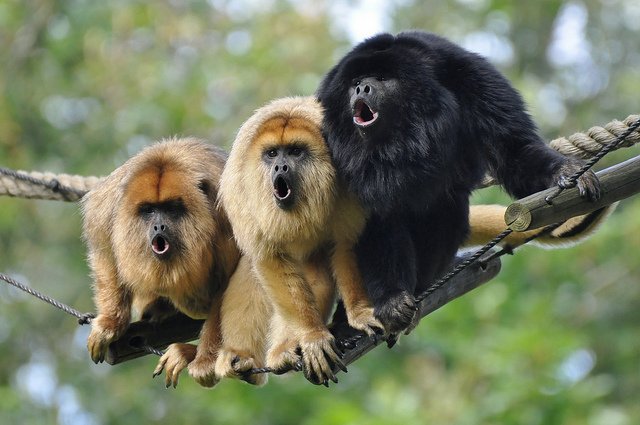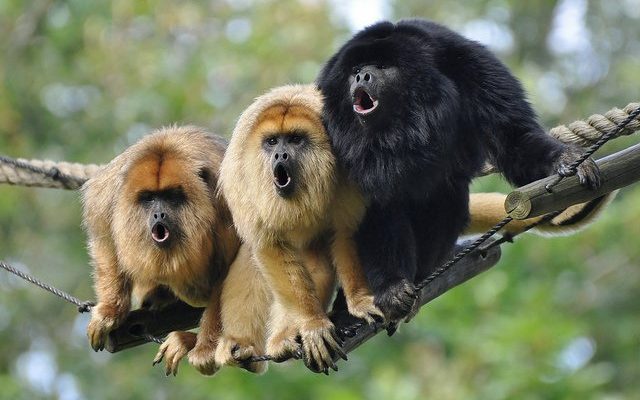
So, what’s the scoop on the evolutionary journey of howler monkeys? It all starts about 40 million years ago when their ancestors split from other primates. Over time, howler monkeys evolved distinct characteristics and behaviors that make them unique. Let’s dive deeper into this evolutionary tale, exploring where they came from, what makes them special, and how they fit into the world today.
The Ancestry of Howler Monkeys
To understand the evolutionary history of howler monkeys, we first need to look at their ancestors. These primates are part of the New World monkeys, a group that split from the Old World monkeys approximately 40 million years ago. This division happened due to geographical changes in the Earth’s landscape, which isolated species and led to different evolutionary paths.
Howler monkeys belong specifically to the family Atelidae. This family is characterized by its large size and prehensile tails, which help these monkeys navigate the treetops. Over time, howler monkeys diverged into different species, primarily found in Central and South America. Each species developed unique adaptations to thrive in their specific habitats, ranging from rainforests to dry, deciduous forests.
There’s also an interesting connection between howler monkeys and their vocalizations. Their impressive howls, which can travel up to three miles, have evolutionary significance. They might have developed this ability to communicate with one another across dense forest canopies, facilitating social bonding and territorial claims. Imagine living in a world where your voice was your strongest tool for survival!
Physical Adaptations: The Key to Survival
As howler monkeys evolved, their physical traits transformed, allowing them to adapt to their environments. One of the most notable adaptations is their prehensile tail. This tail acts almost like a fifth limb, giving howler monkeys the ability to grip branches securely while moving through the treetops. It’s like having an extra hand—super useful for climbing and leaping!
Moreover, howler monkeys have strong, muscular bodies that help them swing gracefully from branch to branch. Their forelimbs are longer than their hind limbs, an adaptation that aids in climbing and hanging. Their powerful jaws and large molars are also designed for their mainly herbivorous diet, focused on leaves, fruits, and flowers. This dietary choice means they naturally play a significant role in their ecosystems as seed dispersers.
Let’s not forget about their unique vocal cords. Howler monkeys possess an enlarged hyoid bone, which acts as a resonance chamber, amplifying their howls. This adaptation not only aids in communication but also helps maintain social structures within troops. It’s fascinating to think of how these physical adaptations have allowed them to thrive under various environmental pressures!
The Social Structure of Howler Monkey Troops
Another intriguing aspect of the evolutionary history of howler monkeys is their social structure. Howler monkeys typically live in groups called troops, which can range from 5 to over 20 individuals. Within these troops, hierarchies and social bonds play vital roles in their daily lives.
Troops generally consist of a dominant male, several females, and their offspring. The dominant male’s role is crucial, as he often leads the troop and defends their territory. This social structure likely evolved for protection against predators and competition for resources. By working together, howler monkeys can alert one another to danger and secure access to food sources.
You might be wondering how they communicate within these social groups. Apart from their iconic howls, howler monkeys use a range of vocalizations, body language, and grooming behaviors to maintain their social connections. Grooming, in particular, is essential for strengthening bonds and establishing trust among troop members. It’s like a community spa day, promoting both hygiene and social cohesion!
Howler Monkeys and Their Ecosystem
Howler monkeys aren’t just fascinating creatures; they play a critical role in their ecosystems. As primarily leaf-eaters, they contribute to shaping the vegetation structure of their habitats. Their selective feeding habits can influence the types of plants that thrive in an area, allowing for a balance in plant diversity.
Moreover, as they consume fruits and leaves, they become vital seed dispersers. When they travel through the forest, howler monkeys excrete seeds in different locations, promoting plant growth in new areas. This behavior helps maintain the health of the forest and supports a variety of other species.
However, habitat loss poses a significant threat to howler monkeys and their ecosystems. Deforestation for agriculture and urban development has led to significant declines in their populations. Protecting their habitats is crucial not just for their survival, but for the overall health of the ecosystems they support.
Threats and Conservation Efforts
Unfortunately, howler monkeys face various threats due to human activity. As mentioned earlier, deforestation is a major issue. The destruction of their habitats can lead to fragmentation, making it difficult for these monkeys to find mates and resources. Additionally, illegal hunting and the exotic pet trade further threaten their populations.
Conservation efforts are underway to help protect howler monkeys and their habitats. Many organizations focus on habitat restoration, reforestation, and legal protection for these primates. Community awareness programs also educate local populations about the importance of conserving howler monkeys and their ecosystems.
You might be surprised to learn that some successful conservation strategies include creating wildlife corridors, which help connect fragmented habitats. These corridors facilitate safe movement for howler monkeys and other wildlife, providing access to food and mates. It’s a collective effort that reminds us of the power of teamwork in conservation!
The Fascination with Howler Monkeys
The evolutionary history of howler monkeys is not just an academic interest; it captures our imagination and hearts. Their unique characteristics, vibrant social structures, and ecological roles make them captivating subjects for study. People often travel to the tropics specifically to observe these remarkable creatures in their natural habitats, marveling at their vocalizations and behavior.
This fascination isn’t just for scientists; it includes nature enthusiasts and travelers alike. Howler monkeys serve as a reminder of the diverse life forms that share our planet and the need to protect them. Their story is intertwined with our own, reminding us of the impact humans have on wildlife and the environment.
In conclusion, the journey of howler monkeys through evolution is a rich narrative filled with adaptations, social dynamics, and ecological significance. Understanding their history helps us appreciate their role in the world and inspires us to take action for their conservation. After all, every howler monkey is a piece of the puzzle we need to protect, ensuring future generations can enjoy their incredible presence in the wild.

